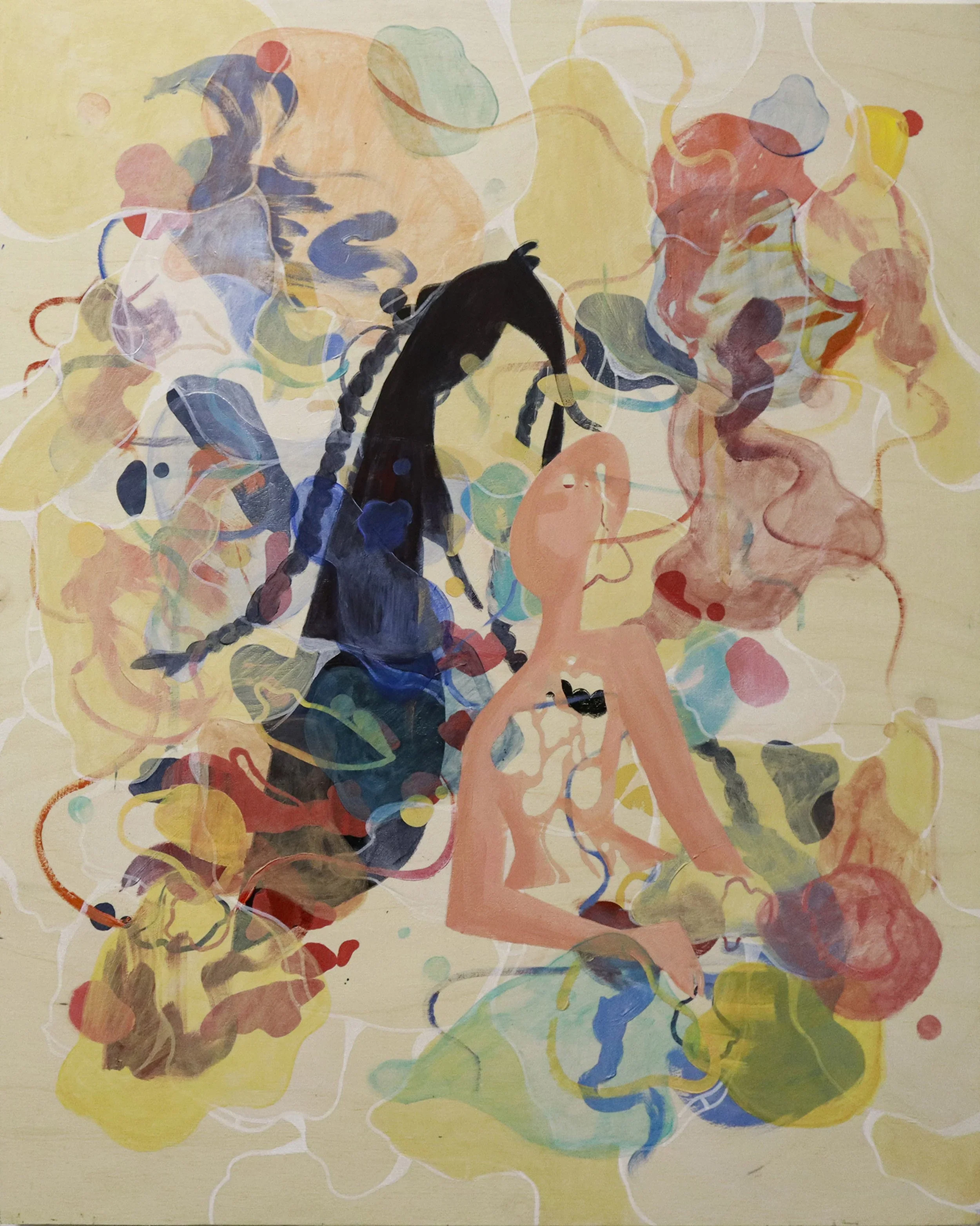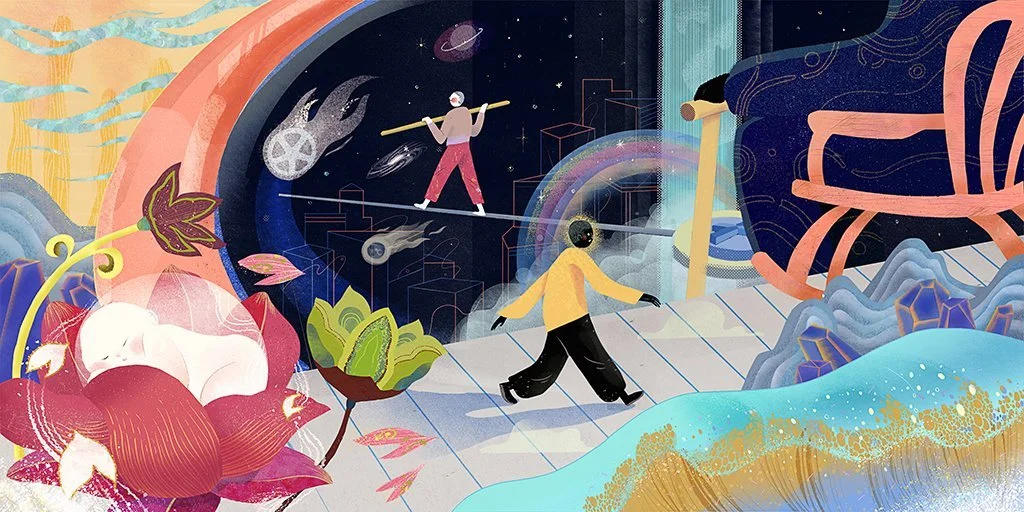10 Questions with Yihan Wang
Al-Tiba9 Art Magazine ISSUE12 | Featured Artist
Yihan Wang was born in China and is an illustration student at the School of Visual Arts, focusing on children’s books and book illustrations.
Yihan mainly discusses psychological problems in our society and uses wild animals and insects as symbols to concrete human mood.
ARTIST STATEMENT
Most people ignore the anxiety of children. When kids encounter a rule for the first time, it is hard to distinguish the line between right and wrong. Although children don’t have financial burdens like their parents, they still face challenges with their friends, school, and family.
In Flowers, the flamingos are packed as a bouquet, and the figure is hiding behind the bouquet. It shows the pure love and happiness of a kid in contrast with self-abasement and fear.
In Wind, the grey gooses and the invisible sense of wind symbolize the fear of growth and unknown things.
Flowers, oil on canvas, 50x70 cm, 2022 © Yihan Wang
Get your limited edition copy now
INTERVIEW
Please, let's talk about your background. Could you tell us more about yourself and how you began making art?
I am from Hainan, an island city in southern China. Before high school, art was one of my hobbies in my spare time, and I was more interested in biology. After I came to America in high school, I met my art teacher, which influenced me a lot, and this is the main reason for me to be an artist.
When did you decide to become an artist? And what do you wish you knew about contemporary art before you got started?
I decided to become an artist in my senior year of high school. I struggled with whether apply for a biology major or an art major. I have always had a huge curiosity and interest in the vital force and the soul of living organs. My art teacher assigned some projects related to personal experience and spirit, which provided opportunities for combining my feeling with art. I wanted more than to be an observer; I also wanted to express my idea. I knew less about contemporary art in high school and had a limited perspective on art. I thought art was to make a beautiful image with a certain emotion. Therefore, I made the mistake of paying too much attention to making something right and subconsciously ignored the concept of art. Contemporary art is about tolerance, courage, and creativity, which break the conservative idea and transmit a new vision.
Black Goat, watercolor, 38x54 cm, 2022 © Yihan Wang
Let's talk about your creative process. Where do you draw inspiration from nowadays?
I have been a sensitive person since I can remember. I have a habit of observing people's attitudes and facial expressions while talking or doing something. In modern society, most people are satisfied with the material demands, then develop more and more complex needs in spirit and mind. Some social events or just little things that happen in my life might inspire me. I will catch the impression in the moment and keep thinking about the elements relative to this impression in the subway or walking. Then, an image forms in my mind so I can paint the picture on canvas or paper.
What is your artistic routine when working? Do you have a set schedule, or do you work following your inspiration?
I usually paint at midnight because the quiet atmosphere facilitates my creativity. I sleep in the morning, then go to school in the afternoon. However, I don't really have a specific schedule for doing art. I won't set a time limit or number of pieces in a new project because I constantly change my idea. I work on many kinds of media, like watercolor, oil, pastel, and etching. Each media creates different senses to the pictures. Sometimes, I will redo the painting if the media I chose doesn't meet my expectations.
In your work, you pair images of kids and animals to express the kids' fears and feelings. What do you want to communicate to the public with this series?
Psychological problems are common in our society and are always related to trauma in childhood. Parents are busy, so they might ignore their children's anxiety. A lot of parents think unusual behavior of children just because kids are young and naught. I hope parents and educators can not only care about the grade of children but also try to build empathy with them.
Weight, oil on canvas, 60x80 cm, 2022 © Yihan Wang
How did you choose which animals to paint and what do they represent for you?
I will pick the animal I have physically seen and touched before, so I know the habit and characteristics of these animals. Also, the feather's color and the shell's pattern symbolize a specific emotion.
What about the colors you use in your paintings? Are they meant to convey a certain feeling or idea?
Color is important in achieving synaesthesia, the most significant thing in a complete artwork. Each artwork creates a unique sound through vision and arouses particular moods in viewers. In "Flowers", the viewer might feel temperature and happiness through the bright pink and soft yellow desert.
Wind, watercolor, 38x54 cm, 2022 © Yihan Wang
How did you develop this idea, and how do you see it evolving in the future? Do you plan to continue this series?
Most people ignore the anxiety of children. When I was a kid, I had difficulty distinguishing right and wrong; also, I was confused after getting the punishment. My younger brother, a ten years old elementary school student, is also experiencing these problems. Although children don't have financial burdens like their parents, they still face challenges with their friends, school, and family. I am continuing this series because my brother is also currently experiencing these problems. I might extend this topic related to family relationships and other social problems.
Talking about the future, what are you working on now, and what are your plans? Do you have any upcoming exhibitions or projects?
I am working on my senior thesis project, eight watercolors about children's psychology—hopefully, I will publish my art books after graduation. Also, I am going to apply for the MFA program next year.
Finally, as you are still very young, where do you see your career and art going in the future? What do you hope to accomplish in the next few years?
I will finish my college study first, find a job to support my art, and go to graduate school. I will continue working on art and psychology and maybe do healing art and art therapy.
























